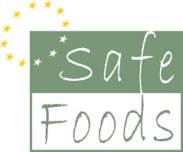
Workplan
The SAFE FOODS project consist of a variety of research projects that jointly constitute the design of a new integrated risk analysis approach for foods. The research is implemented by six workpackages.
Integrated Risk Analysis
This IP consists of a number of interdependent research projects, which will deliver the elements for the construction of the new risk analysis approach (Figure). Results generated in this IP will be incorporated into a new risk analysis framework including also nutrition and labelling issues, which will result in improved consumer confidence in consumer protection activities across Europe. This approach will be based upon qualitative and quantitative methodologies.

Outline Implementation Plan
The following Research Tasks (Workpackages) are included:
- Comparative Safety Evaluation of Breeding Approaches and Production Practices Deploying High- and Low-Input Systems
- Early Detection of Emerging Risks Associated with Food and Feed Production
- Quantitative Risk Assessment of Combined Exposure to Food Contaminants and Natural Toxins
- Consumer Confidence in Risk Analysis Practices Regarding Novel and Conventional Foods
- Investigation of the Institutional Challenges and Solutions to Systemic Risk Management
- Construction of an Integrated Risk Analysis Approach for Foods
Results from the Research Tasks 1-5 will be used to design the New Integrated Risk Analysis Framework in Research Task 6.
Research Tasks are broken down into Sub-Tasks (Workpackage Elements) while the coherence between the Research Tasks is further addressed in the figure: Common Elements of Investigation in the Research Tasks and in the Interdependencies table.
Before implementation of the new risk analysis framework, its acceptability will be tested among stakeholders , i.e. representatives from national and international organisations involved in risk assessment (e.g. EFSA & national food authorities, CODEX, JECFA, etc.) and risk management (e.g. Commission Services, National Food Authorities, FAO/WHO, OECD, etc.), food producers, plant breeders, consumers, and any other relevant stakeholder. This will be done as part of WPs 4-6, by performing case studies and interviews with expert representatives, and in Workshops with User Groups.
The final goal of this IP is to integrate scientific and societal aspects of risk analysis into a framework which is scientifically robust and responsive to societal needs including labelling and nutritional aspects/policies.
Attention is paid in particular to new scientific developments that may be successfully implanted in the risk analysis of foods and to the design of transparent communication strategies for communication about uncertainties and risks.
